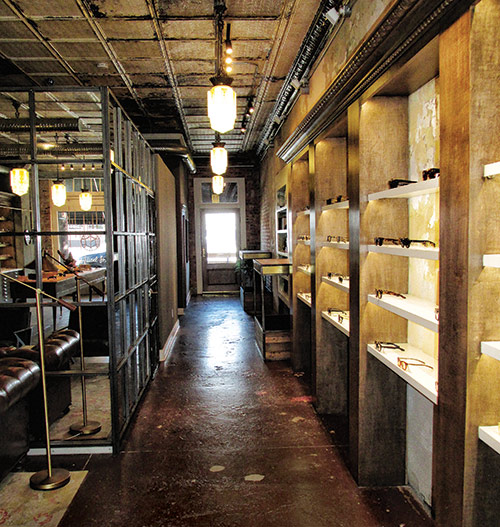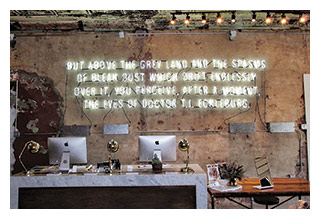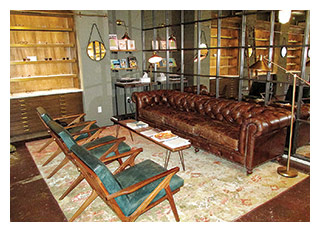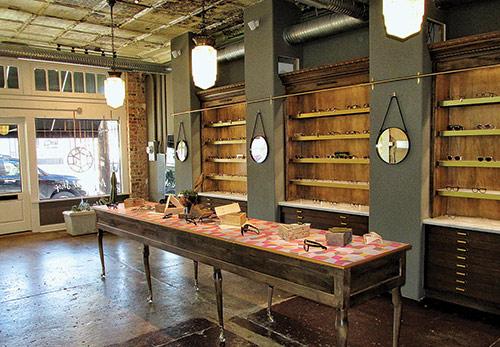
By Preston Fassel
 It’s tucked away in the heart of Dallas’ historic Bishop Arts District. Some consider it one of the city’s most beloved new hangouts. Though barely three years old, it attracts flocks of visitors from every walk of life, from artists to authors, graphic designers to musicians. The smell of fresh-brewed coffee and leather upholstery permeates the place, spacious and cool in the Texas spring, and the soothing tunes of the English band Broadcast lends the place the ambiance of an urban oasis untroubled by the concerns of the outside world.
It’s tucked away in the heart of Dallas’ historic Bishop Arts District. Some consider it one of the city’s most beloved new hangouts. Though barely three years old, it attracts flocks of visitors from every walk of life, from artists to authors, graphic designers to musicians. The smell of fresh-brewed coffee and leather upholstery permeates the place, spacious and cool in the Texas spring, and the soothing tunes of the English band Broadcast lends the place the ambiance of an urban oasis untroubled by the concerns of the outside world. Did I mention this is a dispensary?
As strange as it may seem, Glass Optical has quickly eked out a place for itself as one of the city’s premier hangouts, a place where people can grab a cup of coffee, chat about the latest in politics and pop culture, and most importantly, pick up a new pair of specs, all beneath the calming glow of a fantastic neon sign describing literature’s most famous optical shop, that of Dr. T.J. Eckleburg in The Great Gatsby.
“It was really my son’s idea,” says Stephen Wilkes, OD, who has been in practice for over 20 years and who operates and co-owns Glass with his son Paul. “He grew up in the optical business… He came to me and asked, ‘Do you want to start an optical boutique in Oak Cliff?’ I sold my practice over in Southeast Dallas, and we opened this. His wife designed it, and he was the general contractor.”
On paper, the move was a gambit: As brick-and-mortar optical continues to fight the battle against online, a designer boutique in a historical Texas neighborhood may have seemed like a colossal risk. Yet within two years, any risk taken has paid off phenomenally: Glass Optical has already been called “the best optical boutique” in the city by D Magazine, Dallas’ arts and culture publication, and its reputation—and business—continues to grow.
 “The amount of word of mouth that goes to the office is ridiculous,” says Javier Tellez, Glass Optical’s head optician, who has eight years of experience in the field. “We have people come in from Austin. A Dita Eyewear representative flew in from Houston so he could look at the store. It’s just the whole energy of the store, the whole atmosphere. We get people who don’t want to go to other opticals. They don’t want ‘regular.’ They want somewhere cool, to hang out, to feel welcome. That’s the most important part… you go in any other doctor’s office, and it’s not welcoming. They’re wearing scrubs… ‘Fill this out. Can I see your ID?’ Here, it’s, ‘Hey, how’s it goin’, sir? Come on, have a seat!’ The staff we have has been very specifically picked. Caleb Mathern, for example, is also part of the Dallas art world.”
“The amount of word of mouth that goes to the office is ridiculous,” says Javier Tellez, Glass Optical’s head optician, who has eight years of experience in the field. “We have people come in from Austin. A Dita Eyewear representative flew in from Houston so he could look at the store. It’s just the whole energy of the store, the whole atmosphere. We get people who don’t want to go to other opticals. They don’t want ‘regular.’ They want somewhere cool, to hang out, to feel welcome. That’s the most important part… you go in any other doctor’s office, and it’s not welcoming. They’re wearing scrubs… ‘Fill this out. Can I see your ID?’ Here, it’s, ‘Hey, how’s it goin’, sir? Come on, have a seat!’ The staff we have has been very specifically picked. Caleb Mathern, for example, is also part of the Dallas art world.”In keeping with the store’s retro-chic/artistic aesthetic and philosophy, Glass carries a variety of designer frames from Barton Perreira to Thom Brown, Moscot and Jacques Marie Mage.
“Mykita is very successful,” Tellez says of the store’s best-selling lines. “We actually used to have the shield, and we had a few celebrities come and buy that. We got reblogged by Mykita because of that. Courtland Eyewear is very popular with our African-American patients because it fits their bridges well.” Frames run from very high end to middle road to attract a strata of customers based on lifestyle and fashion rather than socioeconomic status. “We have frames that are $1,000, we have frames that are $150. Everyone is welcome,” Tellez says. It’s a patient-relations strategy that allows Glass to underscore the importance and value of eyewear to a demographic that came of age with the idea of online optical: “We might start someone off with a light frame, $200. They come back the next year, ‘Hey, I trust you guys, what’ve you got?’ We build the clientele little by little. The people that come here are aged 25 to 35, graphic designers, artists. They’ve just gotten off of Warby Parkers, so we start them off very light. The next year we move up.” The biggest seller? Double bars are making a big comeback, Tellez tells me, especially the Bastille by Ahlem.

Helping to underscore the community experience is that all work is done on-site: Wilkes sees patients several days a week, while an in-house lab tech edges lenses at the store. Lenses are all polycarbonate, and most are sold with Crizal Prevencia, an AR that’s been readily embraced by Dallas’ digital natives. Another touch is the store’s rotating window displays, and the “opening parties” thrown every time a new line is introduced, where patients can come and “meet” the new frames they will soon be wearing.
“This is the future of brick-and-mortar optical,” Tellez tells me, and to see the success of Glass—who will soon be expanding its stock to include several European lines—it seems he’s right. “It’s the only way to survive: Stand out from the others. That’s the key. To be different and to provide a service that no one else does: brands, staff… When you go to the doctor’s office, you don’t want to go to the ‘doctor’s office.’ Everything here you can’t get online. The experience, the smell, the lighting, the one-on-one interaction with the patient. You can click on it, you can be at home, but you’re not going to get THAT.” ■










